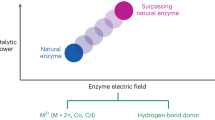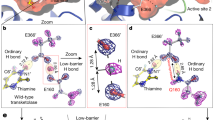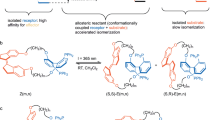Abstract
THE catalytic effectiveness of enzymes arises in part from the bringing together (the “approximation”) of the substrate and catalytic groups of the active site in the formation of the enzyme–substrate complex1. Much of the thinking behind suggestions concerning the importance of approximation has derived from intra-molecular reactions where the proximity between reactive groupings is caused by covalent bonds. While this analogy is quite appropriate for the breakdown of covalent reaction intermediates—for example, acyl-enzymes2—it is not a very close one for the kinetic steps which immediately follow the formation of the enzyme–substrate complex, nor can the first order rate constants from intra-molecular reactions be compared directly with the second order rate constants from corresponding bimoleeular processes except by the incompletely satisfying concept of “effective molarity”3. The rates of inter-molecular catalytic reactions are, in contrast, much more relevant to any assessment of the kinetic importance of approximation, allow rational comparisons to be made between specific and non-specific catalysts, and provide opportunities for studying the kinetic consequences of approximation by the weak intermolecular forces on which the binding of substrate to enzyme depends4. We report here a very large rate enhancement in a non-polymeric system involving the imidazole-catalysed hydrolysis of esters, when the substrate and catalyst are brought together by hydro-phobic forces.
This is a preview of subscription content, access via your institution
Access options
Subscribe to this journal
Receive 51 print issues and online access
$199.00 per year
only $3.90 per issue
Buy this article
- Purchase on Springer Link
- Instant access to full article PDF
Prices may be subject to local taxes which are calculated during checkout
Similar content being viewed by others
References
Bruice, T. C., and Benkovic, S., Bioorganic Mechanisms, 1 (W. A. Benjamin, New York, 1966).
Bender, M. L., Kezdy, F. J., and Gunter, C. R., J. Amer. Chem. Soc., 86, 3714 (1964).
Bender, M. L., Chem. Rev., 60, 53 (1960).
Knowles, J. R., in Proc. 9th European Peptide Symposium, Paris, 1968 (in the press).
Knowles, J. R., and Parsons, C. A., Chem. Commun., 755 (1965).
Koehler, K., Skora, R., and Cordes, E. H., J. Amer. Chem. Soc., 88, 3577 (1966).
Behme, M. T. A., Fullington, J. G., Noel, R., and Cordes, E. H., J. Amer. Chem. Soc., 87, 266 (1965).
Wagner, T. E., Hsu, C., and Pratt, C. S., J. Amer. Chem. Soc., 89, 6366 (1967).
Bruice, T. C., Katzhendler, J., and Fedor, L. R., J. Amer. Chem. Soc., 90, 1333 (1968).
Gitler, C., and Ochoa-Solano, A., J. Amer. Chem. Soc., 90, 5004 (1968).
Bodansky, M., and du Vigneaud, V., J. Amer. Chem. Soc., 81, 5688 (1959).
Häring, M., Helv. Chim. Acta, 42, 1845 (1959).
Author information
Authors and Affiliations
Rights and permissions
About this article
Cite this article
KNOWLES, J., PARSONS, C. Proximity Effect in Catalysed Systems: a Dramatic Effect on Ester Hydrolysis. Nature 221, 53–54 (1969). https://doi.org/10.1038/221053a0
Received:
Issue Date:
DOI: https://doi.org/10.1038/221053a0
This article is cited by
Comments
By submitting a comment you agree to abide by our Terms and Community Guidelines. If you find something abusive or that does not comply with our terms or guidelines please flag it as inappropriate.



